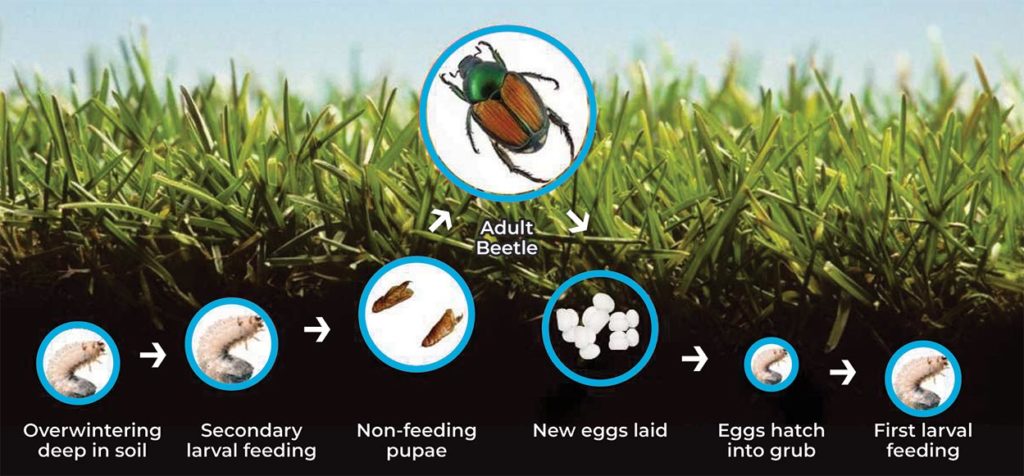PESTS & DISEASES
CONTROLLING GRUBS IN YOUR LAWN
One of the most common lawn pests, grubs leave dry, bare patches on your lawn and foraging raccoons and skunks can further damage by digging. Even worse, most grubs mature into beetles, which can then cause damage to the plants in your garden as well!
Grubs vs. Nematodes vs. BT: What are they?
Grubs are the larva of a number of different insects, usually beetles (including Japanese Beetles). They cause damage to turf grass by feeding on the roots, causing brown, dead patches to appear in spring or fall. Typically those patches will expand outward and the grub population looks for new roots to feed on.
Nematodes are microscopic, non-segmented roundworms that are usually found in the soil and are a naturally-occurring treatment for grubs! These beneficial insects will seek out and enter the bodies of grubs and feed on them from the inside out, typically destroying them in 1-2 days. Beneficial nematodes do not harm humans, pets, or any other beneficial insects in the soil!
BT is a naturally-occuring spore-forming bacterium called Bacillus thuringiensis that has recently been shown to kill grubs. When certain insects (including grubs) ingest BT, it causes their stomach to break down, which kills the insect, though it can take anywhere from a few hours to a number of weeks. BT is non-toxic to birds, fish, and humans, though it can cause some mild skin irritation, so gloves are recommended for application.
Life Cycle
While different types of beetles have grubs as their larvae, most life cycles are fairly similar. Adult beetles dig shallow holes in the soil to deposit their eggs, typically between June and August, depending on the type of insect. The eggs then hatch in roughly 2 weeks, depending on moisture and temperature of the soil, to start the larval (grub) stage. As the larvae get bigger, they will eat more and more roots, which is when homeowners start to notice the damage. Once the ground begins to cool and freeze, the grub will move deep into the soil to wait out the winter, and emerges back up to the surface in the spring to feed again. This secondary feeding also causes damage to your lawn, but lasts only a short time before the larva turns into a pupae. The pupae stage lasts several weeks, but no feeding is done during this time. The pupae then turns into an adult beetle and emerges from the soil to begin feeding and mating. The beetles spend 2-3 weeks laying eggs back into the soil and this completes their life cycle.

Please note, this is just a generalized version of the life cycle of grubs and beetles, and it does vary based on the type of beetle. June beetles, for example, actually have a three year lifecycle, whereas Japanese beetles and European Chafers complete their life cycle within one year. All of them produce a grub, though!
Timing Your Application
Grub control products are most effective at two different periods of the year: in the spring when soil temperatures are above 10°C, and in the fall before the soil temperatures get too cold. Spring tends to be the most common time for an application, but fall is actually more effective as this is when grubs are at their smallest and most vulnerable! For maximum efficacy, we highly recommend you make a grub control application a regular part of both your spring and fall lawn care. Beetles are flying insects, therefore populations tend to spread or return year after year, even if you successfully killed your grub population.
Control Methods & How to Apply Treatment
Nematodes
The most popular control method for grubs is nematodes, and it has been for a number of years. They are purchased in packages containing over 200 million nematodes, and can cover roughly 3000 square feet per package. When applying nematodes, it is best to apply on a cloudy day! If clouds aren’t in the forecast, applications should be laid in the early morning or late evening, when the sun is at its weakest.
Nematodes are best applied to the lawn in a watering can, hose sprayer, or backpack sprayer. It is very important to make sure the sprayer you're using has not been used to apply pesticides or fertilizers as this can kill the nematodes. Always use separate sprayers! Also, be sure to store your nematodes in the fridge if you are not applying them the same day you purchased them.
To apply, mix your nematodes with cool water according to the ratio on the packaging, and apply immediately after mixing. Watering your lawn beforehand or applying after a light rain is recommended as nematodes need moisture to survive. Thoroughly spray your lawn with the nematode solution until you have used all of the solution, and make sure you keep your lawn moist for up to two weeks after application to make sure the nematodes are able to establish themselves.
Bacillus thuringiensis (GrubBGon)
Recently, a new product has been introduced for grub control, called GrubBGon, which contains BT. This product is applied the same way you would a lawn fertilizer as it is a granular form, that is coated in the bacteria. Water your lawn first or apply after a light rain with a fertilizer spreader according to the package instructions, then water lightly again. To be sure the granule has dissolved, water once more a few days later (unless it rains). Do not mow your lawn in between waterings or you will displace the granules before they have a chance to finish breaking down. If you are treating with B.T., products can be applied anytime!




